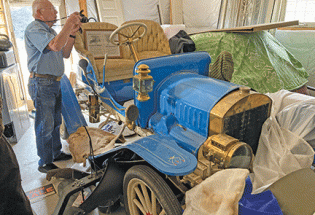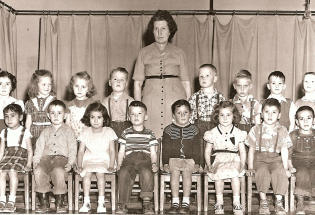It’s irrigating season in the Little Thompson Valley
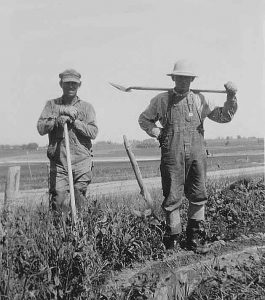
John Waggener Sr. (right) and a hired hand (left) paused while irrigating to pose for a snapshot. Photos of farmers at work are surprisingly scarce and highly prized by the Berthoud Historical Society. Photo courtesy of Jane Vielehr
By Mark French
Tales of the Little Thompson
The Surveyor
Not that many years ago, a farmer irrigating his crops was a common summer sight in the fields around Berthoud. Rubber hip boots, a straw hat, bib overalls and, more often than not, a long-sleeved shirt, characterized the dress of these farmers who tended their water through the heat of the day and the cool of the night. The amount of ditch water available to them was limited to the number of shares they owned, so little was wasted during an irrigation season that extended from May to September. Many of the old irrigation practices have changed with the use of modern, center-pivot sprinklers, but the need for crop irrigation will not diminish as long as there is farming in the Little Thompson Valley.
A canvas dam, that measured perhaps four-by-six feet, and sharp-point shovel were essential irrigation tools for the early farmer. Once a farmer stopped the flow of water in a ditch by setting a canvas dam, he made a series of shallow cuts in the ditch bank to direct the water toward the field. Then he shoveled shallow channels from the cuts to the crop rows so the water could start its downhill trickle to the lower end of the field.
While setting a dam in a ditch required some experience and skill, shoveling channels from the cuts in the ditch bank to the crop rows demanded tedious, back-bending work. In many cases, the channels dug for the first crop irrigation could be used again during subsequent irrigations.
Irrigating also required farmers to walk a great deal. After the water was directed into the rows at the high end of a field, the farmer slogged a good distance to the bottom of the field to see which rows had been soaked. Upon his return to the top of the field, the farmer blocked the channels leading to the soaked rows to avoid wasting water by running it over ground that was already wet.
In the 1920s, J.P. Thompson, who had a harness shop in Berthoud, invented a leather “heel and boot protector” that was marketed to farmers who were plagued by discomfort that resulted from their socks sagging and bunching up in backs of their irrigation boots. His device, that was intended to prevent blisters and sock heels from wearing through, consisted of thin leather straps that were strapped around the heel and tightened with small metal buckles.
Thompson patented his invention, and in 1924 sold it to a national company. There is an example of Thompson’s heel and boot protector in the collection of the Berthoud Historical Society.
The snapshot that accompanies this article shows John Waggener, Sr. and a hired man posing for a photo while irrigating a crop. Even though local farmers spent endless hours irrigating, such photographs are seldom found in family photo albums.
Jane Waggener Vielehr, who is the granddaughter of John Waggener Sr., contributed the photograph for this article. Jane’s father, who was John Waggener Jr., is well-remembered in the Berthoud community. The farm remains in the Waggener family and is located in the Sunnyside district northeast of Berthoud.
- April, 15 2023
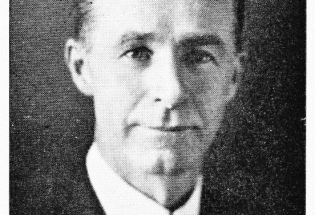
Berthoud schools thrived under hand o...
By Mark French The Surveyor Prior to the consolidation of Berthoud’s rural and town school...
- October, 05 2017
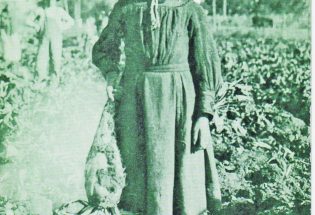
Germans from Russia children help wit...
By Mark French The Surveyor Growing sugar beets in Northern Colorado will always be inextricably...
- May, 26 2016
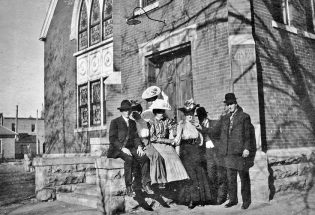
BHS graduation was held at UB Church ...
Mark French Tales of the Little Thompson Surveyor Columnist The Berthoud...
- June, 19 2014
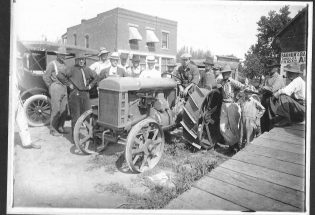
Delivery of first Fordson tractor dep...
Mark French Tales of the Little Thompson The first Fordson tractor...
- August, 06 2014
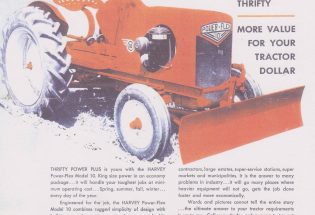
Harvey Power Flex tractor built in Be...
By Mark French The Surveyor In 1958, Wilber F. Gibson built Harvey garden tractors in...
- December, 26 2014

Automobiles raced and wrecked on Kell...
Tales of the Little Thompson By Mark French The Surveyor Sim...
- Asher Architects builds projects from...

- More than a market, a family legacy
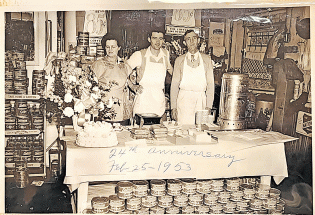
- Colorado business confidence is impro...

- Roy Tripi to become principal of BHS ...

- Teachers express concern about studen...

- Thompson School District faces criti...

- Community Calendar & Legal Notice...

- Community Calendar & Legal Notice...

- Community Calendar & Legal Notice...


POLICEBLOTTER
Community News
Northern Water sets C-BT quota at 70% for 2024
Community News

Emotions run high during Revere Property hearing
Community News
Snowpack at 119% above normal
Community News

Karspeck to serve third term as Berthoud mayor
Community News

OPINION – No bitchin’ allowed
Community News
Roy Tripi to become principal of BHS on July 1
Community News
COMMUNITY CALENDAR:
Community Calendar – add an event
Homestead Fine Art Gallery First Fridays OPEN HOUSE
03 May 4:00 PM - 7:00 PM
Homestead Fine Art Gallery First Fridays OPEN HOUSE
07 Jun 4:00 PM - 7:00 PM
Homestead Fine Art Gallery First Fridays OPEN HOUSE
05 Jul 4:00 PM - 7:00 PM
Homestead Fine Art Gallery First Fridays OPEN HOUSE
02 Aug 4:00 PM - 7:00 PM
Homestead Fine Art Gallery First Fridays OPEN HOUSE
06 Sep 4:00 PM - 7:00 PM
Homestead Fine Art Gallery First Fridays OPEN HOUSE
04 Oct 4:00 PM - 7:00 PM








